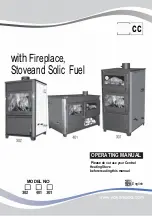
11
6.5
De-ashing the stove
The action of riddling the grate will allow ash to
fall from bed of the fire into the ash pan
underneath.
To riddle the grate place the forked end of the
tool in the slot in the riddling lever located
between the hinges of the bottom door.
Pull and push the lever backwards and forwards
and ash will fall through the grate into the ash
pan.
Remember
To remove the ash pan use the rounded end of
the tool as shown.
When burning wood it is good to maintain a bed of ash on the grate about 1cm
thick.
When burning solid fuel the air is being supplied through the grate therefore it
should not be allowed to get completely blocked with ash.
Do not be tempted to over riddle the grate, as hot or burning fuel may fall through
into the ash pan.
Do not let the ash level in the ash pan get higher than the sides of the pan. This will
reduce airflow to the fire through the grate.
WARNING
Take great care when removing and
emptying the ash pan. It may be very
hot and still contain burning or
smouldering embers and is a fire risk.
12
7 – Guidance on safe operation
Fire can be very dangerous
During operation, the stove and all the fittings (door handles and controls) get very hot.
Do not overfire the stove.
It is possible to fire the stove to such an extent that damage may occur. Look out for parts of
the stove or flue glowing red hot. If such a situation occurs adjust the air supply accordingly
to reduce the burning rate.
Chimney fire
In the event of a chimney fire
Shut all air controls immediately
Raise the alarm and evacuate the building
Call the fire brigade
Do not re-enter the building
Fumes
If installed, operated and maintained correctly the stove will not emit fumes into the room
other than occasionally very small amounts when re-fuelling or de-ashing.
If fumes are being emitted during normal operation
Ventilate the room by opening all doors and windows.
Let the fire burn out
Leave the room
Check the stove, flue and chimney for blockages
Do not re-use the stove until the cause of the problem has been identified and rectified.
If required seek expert help.
Adverse weather conditions
In a small number of installations, very occasionally in specific weather conditions (direction of
wind) the draw of the chimney may be affected causing a downdraught and fumes to be
emitted into the room.
If this is the case the stove should not be used and advice sought from a professional flue
installer who would be able to advise on possible solutions such as an anti-downdraught cowl.


























